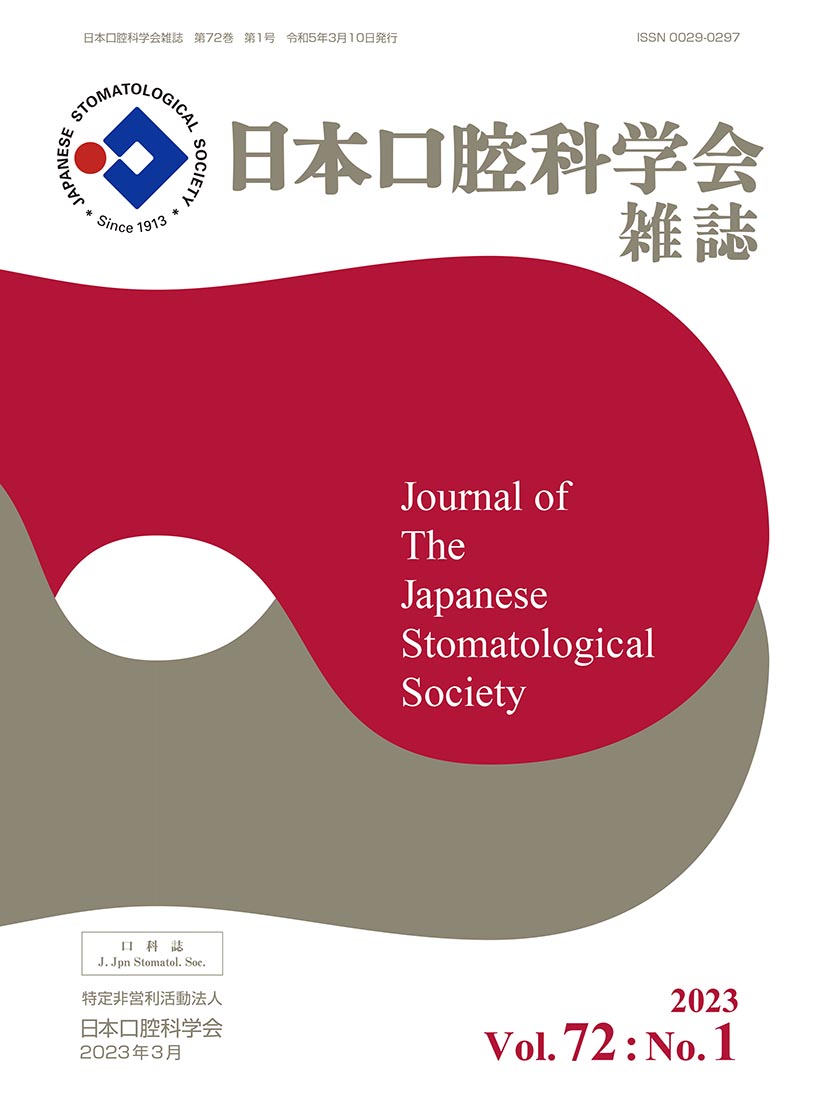All issues

Volume 72, Issue 1
Displaying 1-6 of 6 articles from this issue
- |<
- <
- 1
- >
- >|
-
—A review of key findings from analyses of gene-manipulated mice—Shinsuke OHBA2023 Volume 72 Issue 1 Pages 1-8
Published: 2023
Released on J-STAGE: March 31, 2023
JOURNAL RESTRICTED ACCESSDownload PDF (561K)
-
Junki SAKATA, Yuichiro MATSUOKA, Hidetaka ARITA, Masatoshi HIRAYAMA, N ...2023 Volume 72 Issue 1 Pages 9-14
Published: 2023
Released on J-STAGE: March 31, 2023
JOURNAL RESTRICTED ACCESSSweet’s disease is characterized by three features: acute fever, peripheral neutrophilia, and well-defined tender erythematous plaques or nodules of the skin. We report a case of suspected Sweet’s disease with a chief complaint of swelling and pain of the tongue. A 16-year-old woman was referred to our department because she had cold symptoms, subsequent pain in swollen tongue, and fever of over 38℃. At the initial visit, she presented with fever of 39.1℃, general malaise, eating difficulty, and diffuse swelling and painful erythematous plaque in the skin of the bilateral cheek, chin, and around the lip. Her tongue was fissured and swollen, with conspicuous pain. We consulted with the department of dermatology. Based on laboratory and clinical findings, she was clinically diagnosed with Sweet’s disease following upper respiratory inflammation. She was administered colchicine and potassium iodide, and two days later started receiving steroid therapy. The patient’s symptoms improved after steroid therapy. The dose of steroid was gradually decreased, and the treatment was ended a month and a half after the initiation of steroid therapy. No evidence of recurrence has been observed during 18 months after the treatment.View full abstractDownload PDF (712K) -
Akihiko IIDA, Takanori KOBAYASHI, Kaya NARIMATSU, Tetsuo KIGUCHI, Akan ...2023 Volume 72 Issue 1 Pages 15-19
Published: 2023
Released on J-STAGE: March 31, 2023
JOURNAL RESTRICTED ACCESSFamilial adenomatous polyposis (FAP) is an inherited syndrome in which colorectal polyps occur frequently and develop into colorectal cancer. It may be accompanied by dental abnormalities, such as impacted teeth, osteomatous lesions, and odontomas, which are critical for diagnosis of FAP. Although there have been many reports of dental abnormalities in patients with FAP, there are few reports of cases with FAP diagnosed based on dental abnormalities.
A 13-year-old boy with no medical history or familial history of colorectal cancer visited our hospital with a complaint of delay in tooth replacement. Examination of the limbs and trunk revealed no abnormal findings. In the oral cavity, C⌉ ⌊C ⌈D were overretained. Imaging findings revealed peripheral osteomatous lesions in the skull base and maxillary sinus and multiple osteomatous lesions in the maxilla and mandible. In addition, odontomas were observed in relation to the crowns of 3⌉ ⌊3. ⌈4 was inverted and impacted and an impacted supernumerary tooth was observed.
The patient was referred to a pediatrician due to suspicion of FAP, and upper and lower gastrointestinal endoscopy revealed <100 colorectal adenomas and multiple polyps were observed in the stomach and duodenum. The heterozygous frameshift variant was detected by APC screening.
It is necessary to keep in mind that abnormalities in the oral and maxillofacial region seen in relatively young patients, such as delayed tooth replacement in this case, may lead to the diagnosis of FAP.View full abstractDownload PDF (880K) -
Kenichiro SUZUKI, Hiroshi TAKANO, Mineyo FUKUCHI, Hidemitsu IGARASHI, ...2023 Volume 72 Issue 1 Pages 20-25
Published: 2023
Released on J-STAGE: March 31, 2023
JOURNAL RESTRICTED ACCESSNivolumab is an anti-PD-1 antibody that is an immune checkpoint inhibitor that blocks PD-1/PD-L1 signals and exerts an antitumor effect. Immune checkpoint inhibitors including nivolumab are known to cause various immune-related adverse events including skin disorders. We report a case of erythema multiforme major (EM major) after nivolumab administration.
A 66-year-old female with mandibular gingival cancer (cT4aN2cM0) underwent bilateral neck dissection and mandibular segmental resection in January 2019. After postoperative concurrent chemoradiation (cisplatin + radiation), multiple lung metastases were diagnosed three months postoperatively, and nivolumab 240mg every two weeks was started. Pruritus of the eyes, erythema of the trunk and extremities, and erosion of the oral mucosa occurred after seven doses of nivolumab had been administered. She was referred to a dermatologist and was admitted to the hospital because of suspicion of Stevens–Johnson syndrome. The symptoms improved daily with Prednisolone administration, and she was discharged from the hospital four weeks later. The final diagnosis was EM major.
Nivolumab is effective for head and neck cancers, but adverse events are more diverse than with conventional chemotherapy. Although most of the skin disorders are reported to be mild, it may be necessary to observe them carefully and be important to treat them in the early stage.View full abstractDownload PDF (795K)
-
2023 Volume 72 Issue 1 Pages 26-35
Published: 2023
Released on J-STAGE: March 31, 2023
JOURNAL RESTRICTED ACCESSDownload PDF (618K) -
2023 Volume 72 Issue 1 Pages 36-41
Published: 2023
Released on J-STAGE: March 31, 2023
JOURNAL RESTRICTED ACCESSDownload PDF (538K)
- |<
- <
- 1
- >
- >|